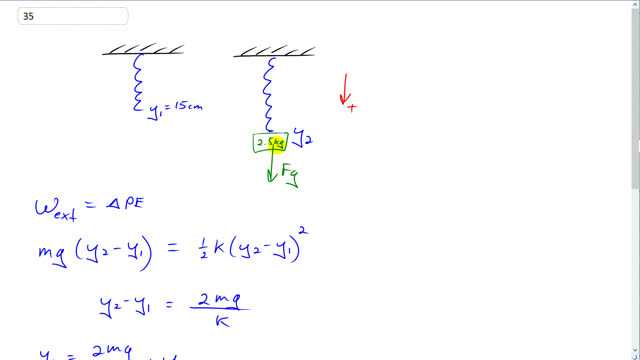
A spring with hangs vertically next to a ruler. The end of the spring is next to the 15-cm mark on the ruler. If a 2.5-kg mass is now attached to the end of the spring, and the mass is allowed to fall, where will the end of the spring line up with the ruler marks when the mass is at its lowest position?

In order to watch this solution you need to have a subscription.
This is Giancoli Answers with Mr. Dychko. Initially, the spring is just at its equilibrium position at a point 15 centimeters along some ruler. And then, a 2.5 kilogram block is placed on it, and the 2.5 kilogram block applies a force downwards over some distance equal to the different between y 1 and y 2, or this distance here. And this work that the block does on the spring, that's the work done by the external force, this gravity that's responsible for the force downwards due to this block, is an external force on the spring and causes a change in potential energy of the spring. And the work done by this gravity force is gonna be the force, mg times the distance over which it's applied y 2 minus y 1. And that's gonna equal the change in potential energy for a spring one-half times spring constant times the final position minus initial position squared. And, we can divide both sides by y 2 minus y 1. And so that makes y 2 minus y 1 to the power of 1 here. And then I multiply both sides by 2 and then divide it by k and so we get, y 2 minus y 1 equals 2mg over k, switch the sides around as well. and then add y 1 to both sides and you get y 2 is 2mg over k plus y 1. So that's 2 times 2.5 kilograms times 9.8 newtons per kilogram divided by 83 newtons per meter— spring constant— plus the 0.15 meters, initial position and we have to write that in meters so that it matches with all the units in this part of the formula; you should always write your units in meters, kilograms and seconds unless you can see that some units are gonna cancel in which case, the units don't matter. But, in this case, when you are adding units, definitely they have to be the same. So we got 74 centimeters, after you convert this answer in meters back into centimeters by multiplying by 100 centimeters per meter. There we go. So the ruler will be 74 centimeters.